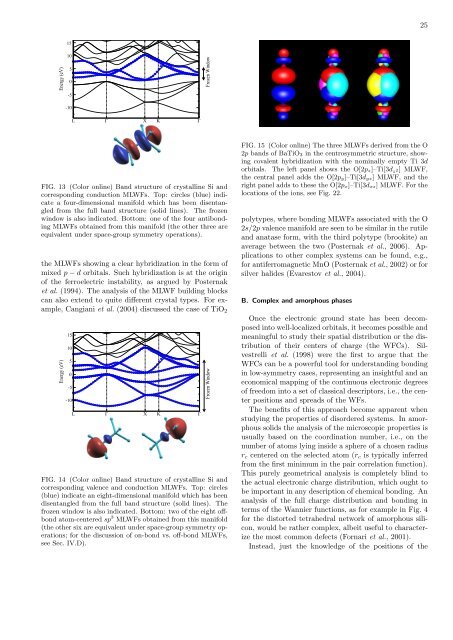Maximally localized Wannier functions: Theory and applications
Maximally localized Wannier functions: Theory and applications
Maximally localized Wannier functions: Theory and applications
Create successful ePaper yourself
Turn your PDF publications into a flip-book with our unique Google optimized e-Paper software.
25<br />
15<br />
Energy (eV)<br />
10<br />
5<br />
0<br />
-5<br />
Frozen Window<br />
-10<br />
L Γ X K Γ<br />
FIG. 13 (Color online) B<strong>and</strong> structure of crystalline Si <strong>and</strong><br />
corresponding conduction MLWFs. Top: circles (blue) indicate<br />
a four-dimensional manifold which has been disentangled<br />
from the full b<strong>and</strong> structure (solid lines). The frozen<br />
window is also indicated. Bottom: one of the four antibonding<br />
MLWFs obtained from this manifold (the other three are<br />
equivalent under space-group symmetry operations).<br />
the MLWFs showing a clear hybridization in the form of<br />
mixed p − d orbitals. Such hybridization is at the origin<br />
of the ferroelectric instability, as argued by Posternak<br />
et al. (1994). The analysis of the MLWF building blocks<br />
can also extend to quite different crystal types. For example,<br />
Cangiani et al. (2004) discussed the case of TiO 2<br />
Energy (eV)<br />
15<br />
10<br />
5<br />
0<br />
-5<br />
-10<br />
L Γ X K Γ<br />
FIG. 14 (Color online) B<strong>and</strong> structure of crystalline Si <strong>and</strong><br />
corresponding valence <strong>and</strong> conduction MLWFs. Top: circles<br />
(blue) indicate an eight-dimensional manifold which has been<br />
disentangled from the full b<strong>and</strong> structure (solid lines). The<br />
frozen window is also indicated. Bottom: two of the eight offbond<br />
atom-centered sp 3 MLWFs obtained from this manifold<br />
(the other six are equivalent under space-group symmetry operations;<br />
for the discussion of on-bond vs. off-bond MLWFs,<br />
see Sec. IV.D).<br />
Frozen Window<br />
FIG. 15 (Color online) The three MLWFs derived from the O<br />
2p b<strong>and</strong>s of BaTiO 3 in the centrosymmetric structure, showing<br />
covalent hybridization with the nominally empty Ti 3d<br />
orbitals. The left panel shows the O[2p z ]–Ti[3d z 2] MLWF,<br />
the central panel adds the O[2p y ]–Ti[3d yz ] MLWF, <strong>and</strong> the<br />
right panel adds to these the O[2p x ]–Ti[3d xz ] MLWF. For the<br />
locations of the ions, see Fig. 22.<br />
polytypes, where bonding MLWFs associated with the O<br />
2s/2p valence manifold are seen to be similar in the rutile<br />
<strong>and</strong> anatase form, with the third polytype (brookite) an<br />
average between the two (Posternak et al., 2006). Applications<br />
to other complex systems can be found, e.g.,<br />
for antiferromagnetic MnO (Posternak et al., 2002) or for<br />
silver halides (Evarestov et al., 2004).<br />
B. Complex <strong>and</strong> amorphous phases<br />
Once the electronic ground state has been decomposed<br />
into well-<strong>localized</strong> orbitals, it becomes possible <strong>and</strong><br />
meaningful to study their spatial distribution or the distribution<br />
of their centers of charge (the WFCs). Silvestrelli<br />
et al. (1998) were the first to argue that the<br />
WFCs can be a powerful tool for underst<strong>and</strong>ing bonding<br />
in low-symmetry cases, representing an insightful <strong>and</strong> an<br />
economical mapping of the continuous electronic degrees<br />
of freedom into a set of classical descriptors, i.e., the center<br />
positions <strong>and</strong> spreads of the WFs.<br />
The benefits of this approach become apparent when<br />
studying the properties of disordered systems. In amorphous<br />
solids the analysis of the microscopic properties is<br />
usually based on the coordination number, i.e., on the<br />
number of atoms lying inside a sphere of a chosen radius<br />
r c centered on the selected atom (r c is typically inferred<br />
from the first minimum in the pair correlation function).<br />
This purely geometrical analysis is completely blind to<br />
the actual electronic charge distribution, which ought to<br />
be important in any description of chemical bonding. An<br />
analysis of the full charge distribution <strong>and</strong> bonding in<br />
terms of the <strong>Wannier</strong> <strong>functions</strong>, as for example in Fig. 4<br />
for the distorted tetrahedral network of amorphous silicon,<br />
would be rather complex, albeit useful to characterize<br />
the most common defects (Fornari et al., 2001).<br />
Instead, just the knowledge of the positions of the













